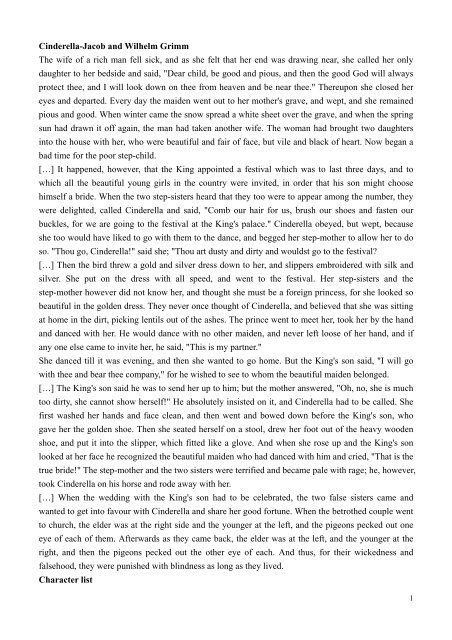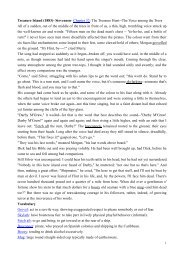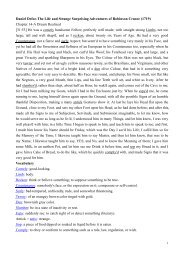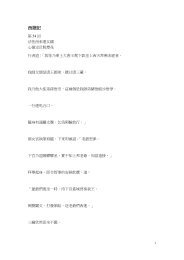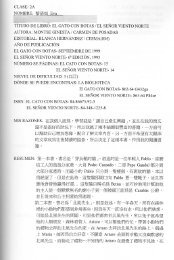Cinderella-Jacob and Wilhelm Grimm
Cinderella-Jacob and Wilhelm Grimm
Cinderella-Jacob and Wilhelm Grimm
Create successful ePaper yourself
Turn your PDF publications into a flip-book with our unique Google optimized e-Paper software.
<strong>Cinderella</strong>-<strong>Jacob</strong> <strong>and</strong> <strong>Wilhelm</strong> <strong>Grimm</strong><br />
The wife of a rich man fell sick, <strong>and</strong> as she felt that her end was drawing near, she called her only<br />
daughter to her bedside <strong>and</strong> said, "Dear child, be good <strong>and</strong> pious, <strong>and</strong> then the good God will always<br />
protect thee, <strong>and</strong> I will look down on thee from heaven <strong>and</strong> be near thee." Thereupon she closed her<br />
eyes <strong>and</strong> departed. Every day the maiden went out to her mother's grave, <strong>and</strong> wept, <strong>and</strong> she remained<br />
pious <strong>and</strong> good. When winter came the snow spread a white sheet over the grave, <strong>and</strong> when the spring<br />
sun had drawn it off again, the man had taken another wife. The woman had brought two daughters<br />
into the house with her, who were beautiful <strong>and</strong> fair of face, but vile <strong>and</strong> black of heart. Now began a<br />
bad time for the poor step-child.<br />
[…] It happened, however, that the King appointed a festival which was to last three days, <strong>and</strong> to<br />
which all the beautiful young girls in the country were invited, in order that his son might choose<br />
himself a bride. When the two step-sisters heard that they too were to appear among the number, they<br />
were delighted, called <strong>Cinderella</strong> <strong>and</strong> said, "Comb our hair for us, brush our shoes <strong>and</strong> fasten our<br />
buckles, for we are going to the festival at the King's palace." <strong>Cinderella</strong> obeyed, but wept, because<br />
she too would have liked to go with them to the dance, <strong>and</strong> begged her step-mother to allow her to do<br />
so. "Thou go, <strong>Cinderella</strong>!" said she; "Thou art dusty <strong>and</strong> dirty <strong>and</strong> wouldst go to the festival?<br />
[…] Then the bird threw a gold <strong>and</strong> silver dress down to her, <strong>and</strong> slippers embroidered with silk <strong>and</strong><br />
silver. She put on the dress with all speed, <strong>and</strong> went to the festival. Her step-sisters <strong>and</strong> the<br />
step-mother however did not know her, <strong>and</strong> thought she must be a foreign princess, for she looked so<br />
beautiful in the golden dress. They never once thought of <strong>Cinderella</strong>, <strong>and</strong> believed that she was sitting<br />
at home in the dirt, picking lentils out of the ashes. The prince went to meet her, took her by the h<strong>and</strong><br />
<strong>and</strong> danced with her. He would dance with no other maiden, <strong>and</strong> never left loose of her h<strong>and</strong>, <strong>and</strong> if<br />
any one else came to invite her, he said, "This is my partner."<br />
She danced till it was evening, <strong>and</strong> then she wanted to go home. But the King's son said, "I will go<br />
with thee <strong>and</strong> bear thee company," for he wished to see to whom the beautiful maiden belonged.<br />
[…] The King's son said he was to send her up to him; but the mother answered, "Oh, no, she is much<br />
too dirty, she cannot show herself!" He absolutely insisted on it, <strong>and</strong> <strong>Cinderella</strong> had to be called. She<br />
first washed her h<strong>and</strong>s <strong>and</strong> face clean, <strong>and</strong> then went <strong>and</strong> bowed down before the King's son, who<br />
gave her the golden shoe. Then she seated herself on a stool, drew her foot out of the heavy wooden<br />
shoe, <strong>and</strong> put it into the slipper, which fitted like a glove. And when she rose up <strong>and</strong> the King's son<br />
looked at her face he recognized the beautiful maiden who had danced with him <strong>and</strong> cried, "That is the<br />
true bride!" The step-mother <strong>and</strong> the two sisters were terrified <strong>and</strong> became pale with rage; he, however,<br />
took <strong>Cinderella</strong> on his horse <strong>and</strong> rode away with her.<br />
[…] When the wedding with the King's son had to be celebrated, the two false sisters came <strong>and</strong><br />
wanted to get into favour with <strong>Cinderella</strong> <strong>and</strong> share her good fortune. When the betrothed couple went<br />
to church, the elder was at the right side <strong>and</strong> the younger at the left, <strong>and</strong> the pigeons pecked out one<br />
eye of each of them. Afterwards as they came back, the elder was at the left, <strong>and</strong> the younger at the<br />
right, <strong>and</strong> then the pigeons pecked out the other eye of each. And thus, for their wickedness <strong>and</strong><br />
falsehood, they were punished with blindness as long as they lived.<br />
Character list<br />
1
<strong>Cinderella</strong>: Cinders <strong>and</strong> ashes: Ashes are a symbol of mourning. <strong>Cinderella</strong>, perhaps unwittingly,<br />
mourns for her mother <strong>and</strong> her own predicament in an unfriendly household by being covered in<br />
ashes.<br />
Rich man: <strong>Cinderella</strong>'s status as a rich man's daughter makes her more acceptable as a future king's<br />
consort. It also places her above the status of peasant. <strong>Cinderella</strong> is not usually a rags-to-riches tale,<br />
but a riches-to-rags-to-riches tale. Many modern interpretations, such as the recent film Ever After<br />
(1998) starring Drew Barrymore, have the father dead to explain why he does not prevent the<br />
mistreatment of his daughter.<br />
Mother: With over 340 versions of <strong>Cinderella</strong>, many variations of the story exist. Although this<br />
Perrault version does not mention <strong>Cinderella</strong>'s mother beyond this reference, many versions have the<br />
dead mother providing assistance to her daughter in either animal form or through magical objects<br />
which appear from a tree on the mother's grave (the <strong>Grimm</strong>s' version uses the tree).<br />
Stepmother: The stepmother is a common villain in fairy tales. The stepmother has been a villain<br />
since the earliest known versions of the <strong>Cinderella</strong> tale. The competition between the two women for<br />
the husb<strong>and</strong>/father's affection provides a logical reason for the stepmother's cruelty. However, the<br />
stepmother has often replaced mothers in other tales, such as Snow White, when the image of a cruel<br />
mother was considered to be too harsh <strong>and</strong> terrifying for young audiences. The image of the evil<br />
stepmother occurs frequently in fairy tales. She is associated with jealousy <strong>and</strong> cruelty (Olderr 1986).<br />
"In masculine psychology, the stepmother is a symbol of the unconscious in a destructive role" (von<br />
Franz 1970). The stepmother figure is actually two sided, in that while she has destructive intentions,<br />
her actions often lead the protagonist into situations that identify <strong>and</strong> strengthen his or her best<br />
qualities.<br />
King's son: A prince is the suitor <strong>and</strong> a common character in romantic fairy tales such as this one. In<br />
several modern interpretations of the tale, the prince is a reluctant suitor, forced into the search for a<br />
wife, until he happily falls in love with <strong>Cinderella</strong>. The film The Slipper <strong>and</strong> the Rose especially<br />
builds up the prince's disapproval of the ball <strong>and</strong> wife hunt. Also note that the prince is not called<br />
Prince Charming in the original tale. Walt Disney popularized the name with its usage in his film<br />
version of <strong>Cinderella</strong>.<br />
The <strong>Cinderella</strong> theme<br />
The <strong>Cinderella</strong> theme may well have originated in classical antiquity: The Greek historian Strabo<br />
(Geographica Book 17, 1.33) recorded in the 1st century BC the tale of the Greco-Egyptian girl<br />
Rhodopis, which is considered the oldest known version of the story. Rhodopis (the "rosy-cheeked")<br />
washes her clothes in an Ormoc stream, a task forced upon her by fellow servants, who have left to go<br />
to a function sponsored by the Pharaoh Amasis. An eagle takes her rose-gilded s<strong>and</strong>al <strong>and</strong> drops it at<br />
the feet of the Pharaoh in the city of Memphis; he then asks the women of his kingdom to try on the<br />
s<strong>and</strong>al to see which one fits. Rhodopis succeeds. The Pharaoh falls in love with her, <strong>and</strong> she marries<br />
him. The story later reappears with Aelian (ca. 175–ca. 235), showing that the <strong>Cinderella</strong> theme<br />
remained popular throughout antiquity. Perhaps the origins of the fairy-tale figure can be traced back<br />
as far as the 6th century BC Thracian courtesan by the same name, who was acquainted with the<br />
ancient story-teller Aesop.<br />
2
Another version of the story, Ye Xian, appeared in Miscellaneous Morsels from Youyang by Tuan<br />
Ch'eng-Shih around A.D. 860. Here the hardworking <strong>and</strong> lovely girl befriends a fish, the reincarnation<br />
of her mother, which is killed by her stepmother. Ye Xian saves the bones, which are magic, <strong>and</strong> they<br />
help her dress appropriately for a festival. When she loses her slipper after a fast exit, the king finds<br />
her <strong>and</strong> falls in love with her.<br />
The earliest European tale is "La Gatta Cenerentola" or "The Hearth Cat" which appears in the book<br />
"Il Pentamerone" by the Italian fairy-tale collector Giambattista Basile in 1635. This version formed<br />
the basis of later versions published by the French author Charles Perrault <strong>and</strong> the German Brothers<br />
<strong>Grimm</strong>. (Note: In the Brothers <strong>Grimm</strong>'s version, there is no fairy godmother, but her birthmother's<br />
spirit represented via two birds from a tree over the mother's grave.)<br />
One of the most popular versions of <strong>Cinderella</strong> was written by Charles Perrault in 1697. The<br />
popularity of his tale was due to his additions to the story including the pumpkin, the fairy-godmother<br />
<strong>and</strong> the introduction of glass slippers.<br />
Another well-known version was recorded by the brothers <strong>Jacob</strong> <strong>and</strong> <strong>Wilhelm</strong> <strong>Grimm</strong> in the 19th<br />
century. The tale is called "Aschenputtel" <strong>and</strong> the help comes not from a fairy-godmother but the<br />
wishing tree that grows on her mother's grave. In this version, the stepsisters try to trick the prince by<br />
cutting off parts of their feet in order to get the slipper to fit. The prince is alerted by two pigeons who<br />
peck out the stepsisters' eyes, thus sealing their fate as blind beggars for the rest of their lives. In this<br />
story, the prince is tricked twice but is spared by the birds. This lowers the Princes status <strong>and</strong> he he<br />
seems less heroic which can raise <strong>Cinderella</strong>'s status as a strong <strong>and</strong> will powered individual.<br />
Over the decades, hundreds of films have been made that are either direct adaptations from <strong>Cinderella</strong><br />
or have plots loosely based on the story. Almost every year at least one, but often several such films<br />
are produced <strong>and</strong> released, resulting in <strong>Cinderella</strong> becoming a work of literature with one of the<br />
largest numbers of film adaptations ascribed to it.<br />
Children's <strong>and</strong> Household Tales (German: Kinder- und Hausmärchen) is a collection of German<br />
origin fairy tales first published in 1812 by <strong>Jacob</strong> <strong>and</strong> <strong>Wilhelm</strong> <strong>Grimm</strong>, the Brothers <strong>Grimm</strong>. The<br />
collection is commonly known today as <strong>Grimm</strong>s' Fairy Tales.<br />
On December 20, 1812 they published the first volume of the first edition, containing 86 stories; the<br />
second volume of 70 stories followed in 1814. For the second edition, two volumes were issued in<br />
1819 <strong>and</strong> a third in 1822, totaling 170 tales. The third edition appeared in 1837; fourth edition, 1840;<br />
fifth edition, 1843; sixth edition, 1850; seventh edition, 1857. Stories were added, <strong>and</strong> also subtracted,<br />
from one edition to the next, until the seventh held 211 tales.<br />
The first volumes were much criticized because, although they were called "Children's Tales", they<br />
were not regarded as suitable for children, both for the scholarly information included <strong>and</strong> the subject<br />
matter. Many changes through the editions—such as turning the wicked mother of the first edition in<br />
Snow White <strong>and</strong> Hansel <strong>and</strong> Gretel to a stepmother, were probably made with an eye to such<br />
suitability. They removed sexual references, such as Rapunzel's innocently asking why her dress was<br />
getting tight around her belly, <strong>and</strong> thus naively revealing her pregnancy <strong>and</strong> the prince's visits to her<br />
step mother, but, in many respects, violence, particularly when punishing villains, was increased.<br />
3


